Under the goal of global carbon neutrality, many climatologists have pointed out another advantage of reducing emissions in response to climate change, that is, improving air quality. In fact, it is also true the other way around.
China’s clean air actions, launched in 2013, have yielded two results: pollution reduction and carbon emission reduction. The emissions of various air pollutants dropped significantly, with the average annual concentration of PM2.5 in 74 key cities decreasing by over 50%; and the net cumulative emission reduction reached 2.43 Gt.
"China's efforts to treat air pollution have resulted in considerable climate benefits. This shows that in the process of achieving the goals of carbon neutrality and carbon peaking, focus should be given to the relevant measures with significant co-benefits when designing emission reduction policies," said Zhang Qiang, a professor from the Department of Earth System Science (DESS), Tsinghua University, to China Science Daily. Recently, Prof. Zhang and his team's related research results have been published in Nature-Communications.
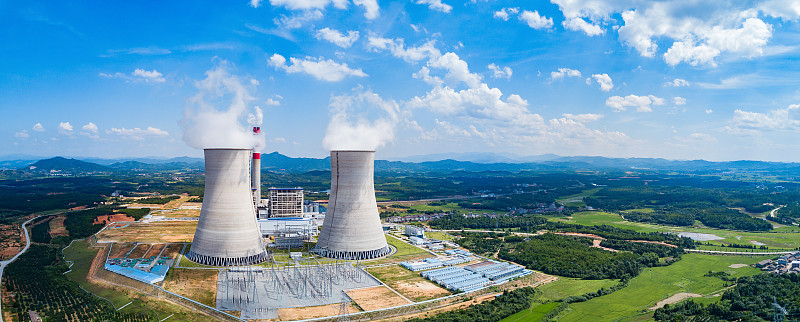
Thermal power station
Considerable co-benefits
Since the 18th National Congress of the Communist Party of China, China has been combating air pollution with unprecedented strength, resulting in historic changes in air pollution control.
In 2013, China launched the "Ten Articles on Air Pollution" (Air Pollution Prevention and Control Action Plan), known as the "most stringent in history", to reduce the concentration of PM2.5 in key areas. In the second phase of air pollution prevention and control from 2018, the "Blue Sky Defense" action plan (Three-Year Action Plan for Winning the Blue Sky Defense Battle) was launched to further improve air quality nationwide.
The researchers, adopting the China Multi-resolution Emission Inventory of China (MEIC) developed by Tsinghua University in their assessment, have found that eight years’ hard work has resulted in significant drop in China's air pollutant emissions. From 2013 to 2020, the national emissions of sulfur dioxide, nitrogen oxides and primary PM2.5 decreased by 69%, 28% and 44% respectively. In the same period, the average annual concentration of PM2.5 in 74 key cities dropped from 72 μg/m3 to 34 μg/m3.
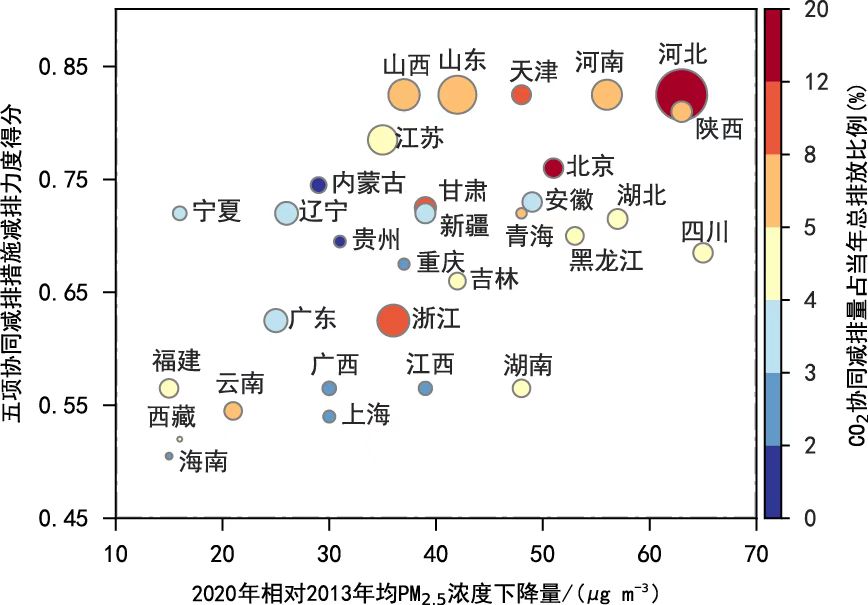
Fig. The relationship between the policy effectiveness of co-beneficial, the annual average PM2.5 concentration decline and CO2 emission reduction in different provinces
"During the clean air actions, the GDP continued to grow and the air quality improved significantly, which means that China has basically decoupled economic growth from air pollution," said Prof. Zhang Qiang, the corresponding author of the article.
In addition, during this period, the cumulative net carbon dioxide emission reductions brought by the co-beneficial treatment measures in China's eight-year clean air actions amounted to 2.43 Gt, exceeding the cumulative increase of carbon dioxide emissions (2.03 Gt) in the same period, and much higher than the additional increase of 230 million tons of carbon emissions caused by the installation of end-of-pipe pollution control devices.
What does the reduction of emissions by 2.43 billion tons mean? This is not far from the achievements of China's green and low-carbon energy transformation as the main force of emission reduction over the past decade. Since 2012, the proportion of clean energy consumption in China has increased from 14.5% to 25.5%, and the clean and efficient utilization of coal has achieved remarkable results, reducing CO2 emissions by 2.94 Gt.
"In the past, international research paid more attention to the benefits of air quality improvement resulting from climate policies. China's clean air actions, though not oriented towards the climate goals, have also yielded considerable co-benefits of CO2 emission reduction," said He Kebin, co-author of the article, Director of Tsinghua University Institute for Carbon Neutrality and Academician of the Chinese Academy of Engineering.
Behind the "Miracle"
As a matter of fact, China's overall efforts to control and prevent air pollution are quite striking even on the world stage.
With regard to Beijing, for example, in 2021, its air quality was fully up to standard for the first time, with the average annual concentration of PM2.5 dropping to 33 μg/m3, down 43.1% from 2017. "Beijing Blue" has gradually become a new normal, lauded as the "Beijing Miracle" by the United Nations Environment Agency, which has issued an independent assessment report to provide reference experience for other cities in air pollution control.
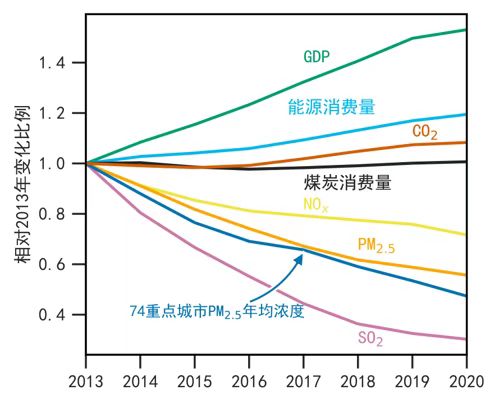
Fig. Changes of anthropogenic emissions, annual average PM2.5 concentration, energy consumption and the GDP in China from 2013 to 2020
Behind the increasing blue sky as the "background color" of the city are multi-pronged stringent measures to control pollution. The researchers analyzed five measures with air treatment and co-benefits of CO2 emission reduction. Among them, the phasing out of backward production capacity and the replacement of industrial coal-fired boilers are the two measures that make the greatest contribution to China's co-benefit emission reduction. Over the past eight years, outdated capacity in several industrial sectors were phased out and replaced with of advanced technologies, including a total coal-fired power plant production capacity of 45 GW, steel production capacity of 312 million tons, cement production capacity of 388 million tons and flat glass production capacity of 192 million weight boxes. About 650 thousand T/h small coal-fired industrial boilers were eliminated.
"With regard to the replacement of industrial coal-fired boilers, for example, the combustion efficiency of small coal-fired boilers is low, only about 65%, or even lower. If replaced by a large coal-fired boiler, the combustion efficiency can reach more than 84%. In this process, co-benefits of reducing pollution and carbon are produced by reducing the use of coal,” said, Zheng Bo, co-first author of the article, who is Assistant Professor of Shenzhen International Graduate School, Tsinghua University.
In addition, in promoting clean fuels in the residential sector, over 29 million households quit from coal-fired heating systems and shifted to natural gas and electricity under the clean air action, with more than 300 thousand steam tons of residential coalfired boilers eliminated. The "scattered pollution" rectification action started in 2016 shut down, banned or upgraded about 660,000 enterprises. More than 26 million yellow-label vehicles and old vehicles have been eliminated.
The cost of these measures was not low. The researchers estimate that the average unit cost of per abated CO2 emission of five co-beneficial measures is estimated to be about RMB 663 yuan per ton, much higher than the traditional carbon dioxide reduction measures, such as the development of non-fossil power (76~83 yuan) and the energy-saving renovation of thermal power plants (408 yuan). "However, considering that the substantial health benefits generated by co-benefit reduction measures through improving air quality can compensate for or even offset the cost of emission reduction, co-benefit emission reduction measures are still competitive,” said Zheng Bo.
These radical governance measures have achieved remarkable results. Over the past eight years, the five co-beneficial measures cumulatively saved 1.06 billion tons of standard coal, equivalent to about 1/5 of the annual energy consumption in China now (about 5.24 billion tons of standard coal).
Such measures have significantly improved regional air quality. For example, the four key regions for air pollution prevention and control, Beijing-Tianjin-Hebei, the Yangtze River Delta, the Pearl River Delta and the Fenwei Plain, contributed 53.2% of the total co-beneficial CO2 emission reduction in China in 2020. Among them, the Beijing-Tianjin-Hebei region contributed the most, followed by the Yangtze River Delta, the Fenwei Plain and the Pearl River Delta.
Provinces with stricter pollution control policies have also achieved more significant reductions in PM2.5 concentration and co-beneficial carbon emission reduction. Hebei, Shandong, Zhejiang, Shanxi and Henan are the five provinces with the largest co-beneficial carbon emission reduction. In 2020, the co-beneficial carbon emission reduction will account for 5.9%~13.2% of the total local carbon emissions, indicating that clean air action is an important driving factor to achieve carbon emission reduction in these provinces.
Inspiration from China's Experience
"China's clean air policy has a direct impact on global carbon emissions," said Zhang Qiang. Since 2013, clean air actions in China have pushed CO2 emissions onto a plateau, while carbon emission reductions in the United States and the European Union offset the increase of emissions in India and other parts of the world. China’s measures play an important role in stabilizing global CO2 emissions.
At the same time, Prof. Zhang noted that despite the remarkable results achieved in the co-beneficial emission reduction of China’s Clean Air Actions, China still should further optimize its energy system and economic structure to promote the realization of the double goals of carbon neutrality and carbon peaking.
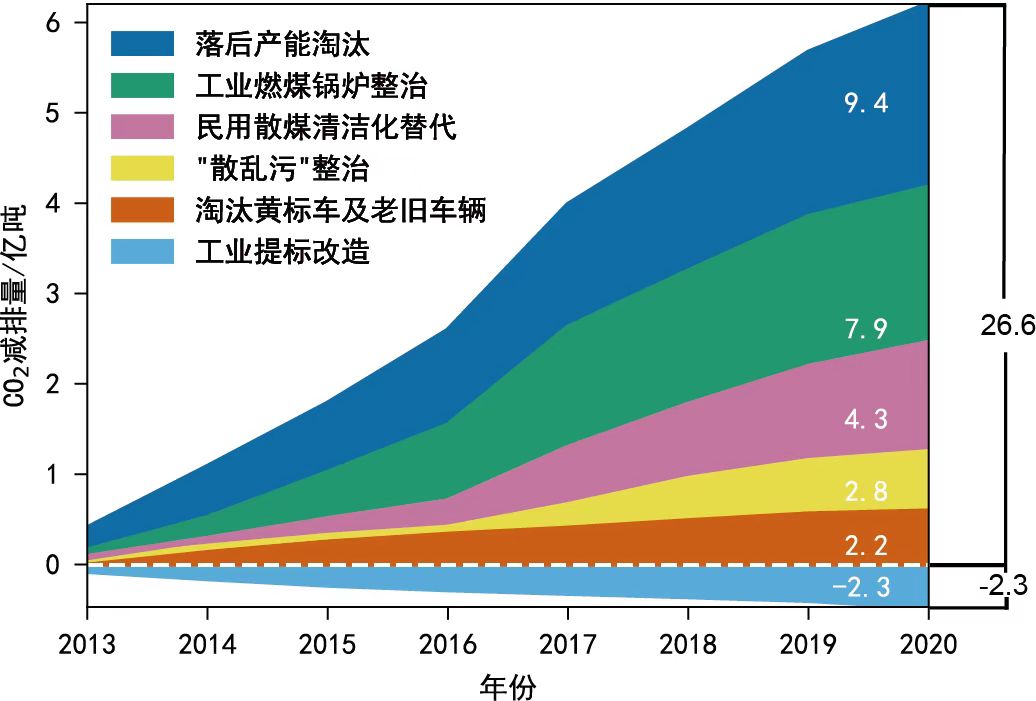
Fig. Accumulated CO2 emission reduction between 2013 and 2020 by each measure
On the one hand, after decades of rapid growth, CO2 emissions in China hit a plateau from 2013 to 2016, closely related to the decline of coal consumption. However, after 2016, with the increase of total fossil fuel consumption, CO2 emissions rebounded.
On the other hand, end-of-pipe treatment measures such as phasing out outdated production capacity still play an important role in reducing pollution and carbon emissions in the short and medium terms, but with the gradual release of their emission reduction potential, they may not be able to support the realization of China's long-term goal of air quality improvement. It is imperative to further strengthen the relevant co-beneficial emission reduction measures such as clean power structure, energy transformation of the industrial sector, building energy conservation, clean residential heating and electrification of motor vehicles.
By 2021, the average annual concentration of PM2.5 in China had dropped to 30 μg/m3, which, however, was still far from the WHO's ultimate guideline value of 5 μg/m3. "With the implementation of Clean Air Actions, a large number of inefficient factories in China have been upgraded or phased out, and the overall energy efficiency of the industry in China has been upgraded," said He Kebin, "With the goal of basically reaching the urban air quality standard nationwide around 2035 and achieving carbon neutrality by 2060, China urgently needs a co-beneficial plan to address climate change and air pollution."
He suggested that measures with co-benefits of CO2 emission reduction should be given priority in future policy formulation, in efforts to achieve co-benefits between climate change and air quality improvement in terms of goals, policies, measures and management.
Besides, the researcher noted that China's experience of co-beneficial pollution reduction and carbon emission reduction offer important inspirations for other developing countries. Many countries in South Asia and Africa are currently in the stage of rapid economic development, characterized by huge consumption of fossil fuels and serious air pollution problems. Local governments tend to take air pollution control as a starting point of their policies. Due to economic pressure and other factors, it is difficult for developing countries to realize low-carbon transformation in a short time. China's experience of co-benefit governance offers a transitional plan for the reference of other developing countries plagued with air pollution problems.
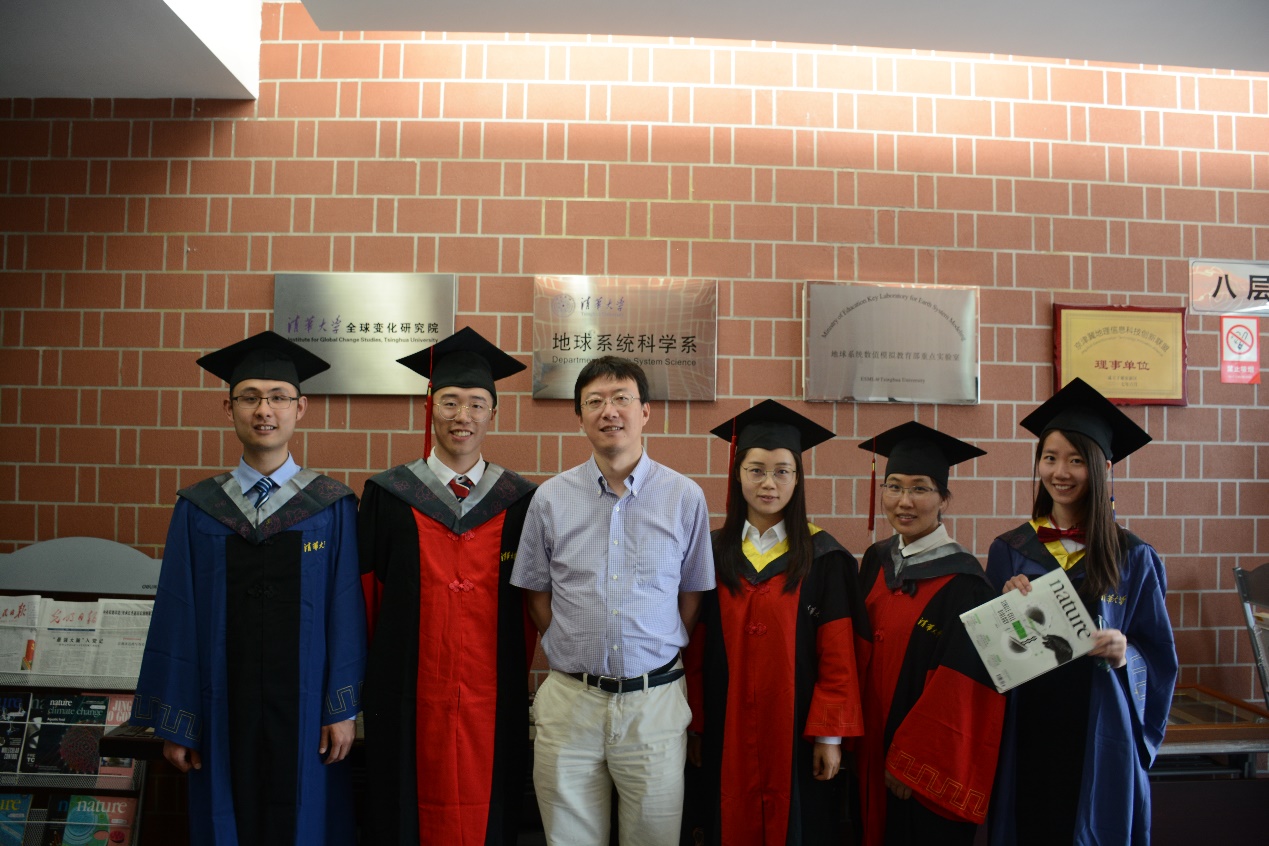
Zhang Qiang with his students
Full-text link of related paper:
https://doi.org/10.1038/s41467-022-32656-8
Written by Feng Lifei